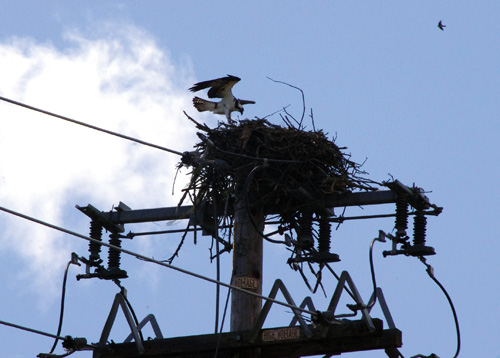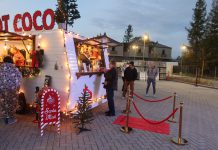
Ospreys make home on PG&E pole despite company efforts to move nest
Residents of Geyserville have some new neighbors. Well they’re actually not that new, they’ve been around since at least 2012, and though their home was demolished last year, they’re back and have rebuilt, so it seems they’re there to stay.
Drivers crossing the Russian River on Highway 128 outside of Geyserville might notice a large nest atop a utility pole on the east bank. The nest is home to a family of ospreys, a raptor or predatory bird that feeds on fish.
Those watching the nest for any significant amount of time will no doubt see ospreys coming and going, standing guard on the nest and perhaps the head of a fledgling peeking over the edge.
Adjacent to the nest is another, taller pole, with a round tray at its apex.
Local resident Leslie Simmons saw a nest there in early spring of 2012, too, as well as some activity from PG&E later that summer.
“I remember seeing a long pole on the ground for a couple of days and then we actually saw PG&E come out and take down the nest,” Simmons said. “I was thinking, ‘Wow, that’s sort of sad, why are they taking the nest down?’ Then I saw them erect this pole with the tray at the top and thought, ‘Oh, they’re trying to get the birds to move.’”
Spokeswoman for PG&E, Brittany McKannay, confirmed that they’d been trying to persuade the osprey family to move from the utility pole, which could potentially put the birds at risk.
“Last year we constructed a pole and basket that our environmental biologists and avian protection team had hoped would guide the bird to nest there,” McKannay said. “The effort was to build the new pole taller than the original pole because birds normally go to the tallest point. Unfortunately it was not the case.”
This is not entirely surprising according to Bill Doyle, president of the Redwood Region Ornithological Society.
“Osprey are extremely site loyal,” Doyle said during a visit to the nesting site. “Odds are if they removed the nest, the birds would build it again next year in the exact same spot.”
The osprey like exposed nesting sites and this one, overlooking a bend in the river, is just about ideal for the fish hunters, Doyle said.
Osprey are a protected species and disturbing a nest, especially with fledglings inside it, would be a felony, he said.
PG&E’s McKannay was aware of the delicacy of the situation, she said.
“If eggs or young are in the nest, we don’t want to interrupt that,” she said. “So we might wait until the nesting season is over and then we’d bring in people to work on other ways to encourage the birds to nest on the alternate site.”
Doyle is not optimistic about the basket for the osprey nest, however. He compared the size and shape of the existing nest with the platform and was skeptical that it would be a suitable surrogate.
“The platform looks pretty small, I’d think it needed to be another foot in diameter to support the nest that is on the utility pole now,” he said. “Also there are very few things in nature that are round. There’s nothing in the osprey’s environment that is round, whereas the cross bars on the power pole are very much like the snags they would use if the power pole wasn’t around.”
The birds can use the lattice of cross bars to interweave elements of the nest, Doyle said, creating a more stable platform in an environment where nests falling from their perch is a serious threat.
PG&E is not giving up on its efforts to have the birds move, however.
McKannay said a team would be going out in the next week to reevaluate the situation along with an environmental biologist.







